Audiometry & Objective Tests for Hearing Assessment
Introduction to Advanced Hearing Assessment
Building upon the foundational clinical and tuning fork tests, advanced audiometric and objective assessments provide precise, quantitative data crucial for comprehensive hearing diagnostics. These sophisticated tools enable clinicians to pinpoint the type, degree, and specific site of auditory lesions, guide rehabilitative strategies, and monitor treatment outcomes. This chapter delves into the intricacies of these advanced tests, essential for MBBS and ENT PG students to achieve strong conceptual clarity and excel in their examinations.
Audiometry tests
Audiometry tests are essential assessments used to evaluate an individual’s hearing capabilities. Various types of audiometry tests are employed, including
- Pure Tone Audiometry
- Speech Audiometry
- Bekesy Audiometry
- Impedance Audiometry.
1. Pure Tone Audiometry (PTA)
PTA is a subjective test designed to determine the hearing threshold for pure tones, which are sinusoidal waves characterised by a single frequency, amplitude, and phase. Pure Tone Audiometry (PTA) is considered the gold standard for measuring hearing thresholds.
- Instrument: The test utilises an instrument called an audiometer, which is an electronic device that produces pure tones. The intensity of the audiometer can be increased or decreased in 5 dB steps.
- Audiogram: During the test, the threshold intensity for each frequency is measured and recorded in a graphical representation known as an audiogram.
- Components of an Audiometer. An audiometer is composed of several key parts:
- Electronic Oscillator: This component generates pure tones across a range of frequencies, from low to high.
- Intensity Dial: This dial allows the examiner to adjust the threshold intensity of hearing for each tone.
- Headphones: These deliver pure tones of various frequencies to each ear separately via air conduction.
- Bone Conductor: A vibrator placed on the mastoid or forehead to deliver sound via bone conduction
Prerequisites for PTA. For accurate results, PTA should be conducted under specific conditions:
- Sound-Proof Environment: The test should take place in a sound-proof room, with ambient noise levels accepted at less than 35 dB.
- Minimising Distractions: Transient noises, such as sneezing or coughing, should be avoided, as they can interfere with the test results.
- Examiner-Patient Interaction: The patient sits in a soundproof booth while the examiner conducts the audiometry from outside. Communication can occur via intercom or face-to-face to observe the patient’s reactions.
Procedure of PTA. The testing process follows a standardised sequence to ensure reliability. The testing process typically begins with the better ear.
- Air Conduction (AC) Testing: The thresholds for pure tones are measured in the following order: 1000 Hz, 2000 Hz, 4000 Hz, and 8000 Hz, followed by 500 Hz and 250 Hz. If there is a difference of 20 dB or more between contiguous frequencies, inter-octave frequencies (750 Hz, 1500 Hz, 3000 Hz, and 6000 Hz) will also be tested. The procedure is then repeated for the other ear.
- Bone Conduction (AC) Testing: After completing AC testing for both ears, conduct bone conduction testing if an air-bone gap (ABG) is suspected or to confirm sensorineural thresholds. BC thresholds are typically measured at 500 Hz, 1000 Hz, 2000 Hz, and 4000 Hz. There’s usually no need to retest 1000 Hz for BC if it was the initial AC frequency.
Bracketing Technique (Modified Hughson-Westlake Method)
The bracketing technique, also known as the 10 dB down, 5 dB up method, involves delivering each test signal at an audible level (e.g., 30 dB HL), then reducing the volume in 10 dB steps until the signal becomes inaudible. The volume is then increased in 5 dB increments until the patient can perceive the sound again. Repeat this down-10, up-5 sequence to find the hearing threshold.
Pure Tone Audiogram is a graphical representation of hearing detection thresholds in each ear across different frequencies.
- X-axis: Represents frequency (Hz), typically ranging from 125 Hz to 8000 Hz.
- Y-axis: Represents hearing level (dB HL), with lower (negative) dB values indicating better hearing and higher dB values indicating poorer hearing.
- Symbols: Standardized symbols denote air conduction (AC) and bone conduction (BC) for each ear (e.g., Red ‘O’ for Right AC, Blue ‘X’ for Left AC; Red ‘<‘ for Right BC unmasked, Blue ‘>’ for Left BC unmasked; Red ‘[‘ for Right BC masked, Blue ‘]’ for Left BC masked).
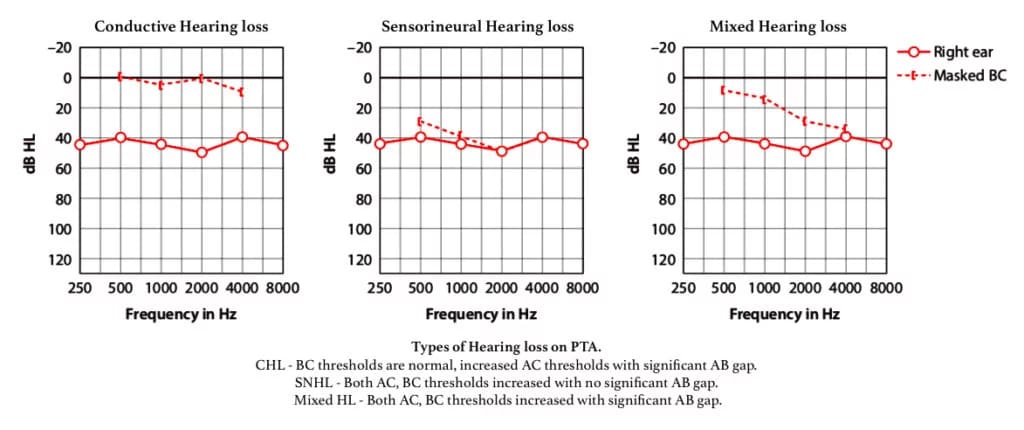
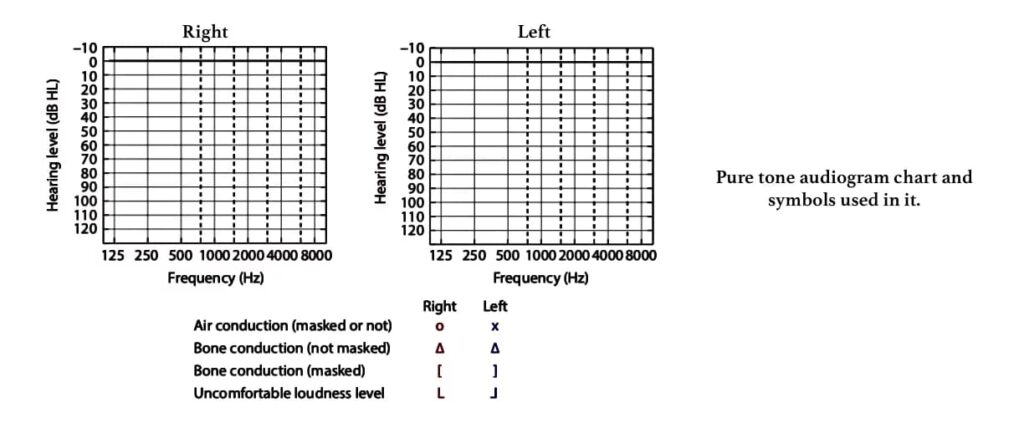
Masking is the process of introducing a noise (a masker) to the non-test ear to prevent it from hearing the sound intended for the test ear. This is important, especially when there’s a significant difference in hearing between the two ears.
- Principle: When a sound is presented to one ear, it can cross over (transcranially) to the opposite cochlea if it’s loud enough. This phenomenon is called cross-hearing or transcranial transmission. The amount of sound energy lost as it travels from one ear to the other is called interaural attenuation (IA).
- Masking for Bone Conduction (BC) Tests:
- Masking the non-test ear is always required in all bone conduction tests.
- Why? Because bone-conducted signals vibrate the entire skull, stimulating both cochleae simultaneously, regardless of where the bone conductor is placed. Therefore, to ensure you are measuring the bone conduction of only the test ear, the non-test ear must be masked with a narrow band noise.
- Masking for Air Conduction (AC) Tests: However, for air conduction tests, a continuous masking noise (or masker) is required only when the interaural hearing difference (AB gap) exceeds 40 dB or more (when using supra or circum-aural headphones), or 55 dB or more (when using insert earphones). This is done to avoid transcranial transmission/ interaural attenuation/ cross-hearing and accurately measure hearing in each ear.
Interpretation of PTA Results. The results of PTA can indicate different types of hearing loss:
- Conductive Hearing Loss: Identified when there is a difference of more than 10 dB between air conduction and bone conduction thresholds at any frequency. The bone conduction thresholds are within normal limits (or near normal, ≤ 20 dB HL),
- Sensorineural Hearing Loss: Identified when bone conduction thresholds are raised above 20 dB HL. There is no significant air-bone gap (typically ≤ 10 dB).
- Mixed Hearing Loss: Occurs when bone conduction thresholds are raised above 20 dB HL, accompanied by a significant air-bone gap (ABG).
Utilisation of PTA. PTA serves multiple purposes in audiology:
- Determining Hearing Loss: It helps identify the type, degree, and configuration (shape of the audiogram, e.g., sloping, flat) of hearing loss. The air conduction pure tone audiogram primarily measures the degree of hearing loss, while the bone conduction audiogram differentiates between conductive and sensorineural hearing loss.
- Medicolegal Assessment: PTA can confirm the degree of hearing impairment for legal and insurance purposes.
- Hearing Aid Prescription: The audiogram is crucial for accurately prescribing hearing aids.
- Speech Reception Threshold: PTA also assists in determining the speech reception threshold of the subject.
Disadvantages of PTA. Despite its advantages, PTA has some limitations:
- Subjectivity: The test results are based on the patient’s responses, which can introduce variability.
- Potential for Malingering: Results may be inaccurate if the patient is feigning hearing loss.
- Age Considerations: The test may yield unreliable results in children under the age of seven, as it depends on cognitive development and cooperation.
2. Speech audiometry. (Assessing Hearing Ability and Speech Comprehension). Speech audiometry is an essential tool for evaluating a patient’s hearing ability and understanding of spoken words. The results of this test are plotted on a graph. The test is also useful for detecting retrocochlear pathology and non-organic hearing loss.
- Speech Reception Threshold (SRT): Also known as the Speech-awareness threshold (SAT), SRT is the lowest speech intensity at which a patient can correctly repeat or detect 50% of the words.
- Procedure: The test involves delivering recorded tapes or monitored voice of spondee words (two-syllable words with equal stress on each syllable, such as “pancake,” “hardware,” “playground”) through headphones or speakers in a soundproof room. The intensity of these words is varied in 5 dB steps until the patient correctly identifies half of them.
- Interpretation and Reliability: For a normal adult, the SRT should be within 10 dB of the pure tone average (500, 1000, and 2000 Hz). An SRT that is better than the pure tone average by more than 10 dB suggests functional hearing loss or an unreliable pure tone audiogram.
- Speech Discrimination Score (SDS):
- Also known as the speech recognition or word recognition score, SDS measures the patient’s ability to understand speech clearly.
- A list of 25 to 50 phonetically balanced words (single-syllable words such as “pin,” “sin,” “day,” “bus”) is presented to each ear separately at 30–40 dB above the patient’s SRT using pre-recorded material.
- The percentage of words correctly identified by the patient is recorded.
- In normal hearing and conductive hearing loss, a high score of 90–100% is typical.
Table : Ability to understand speech and its relation to speech discrimination (SD) score. A list of 50 PB words is presented and the number correctly heard is multiplied by 2 the number
| SD score | Ability to understand speech |
| 90–100% | Normal (Excellent) |
| 76–88% | Slight difficulty (Good) |
| 60–74% | Moderate difficulty (Fair) |
| 40–58% | Poor |
| <40% | Very poor |
Interpretation of Speech Discrimination Scores
- Conductive Hearing Loss: Patients typically show improved recognition scores when the speech signal intensity is increased.
- Sensorineural Hearing Loss: Patients usually do not show improved recognition scores with increased intensity because louder sounds can distort the speech signal.
- Retrocochlear Pathology: Patients may exhibit a reduction in recognition scores with increased intensity, known as the “rollover” effect, which suggests a lesion in the eighth cranial nerve. In this scenario, as speech intensity increases beyond a certain level, the word recognition score declines rather than stabilizing as it does in cochlear sensorineural hearing loss.
Performance Intensity Function for PB Words
- PB Max: It is beneficial to plot PB scores against various speech intensity levels to determine the maximum score (PB max) a person can achieve, rather than using a single suprathreshold intensity of 30–40 dB above the SRT. The intensity at which PB max is achieved is noted, and the maximum volume of a hearing aid should be set below this level.
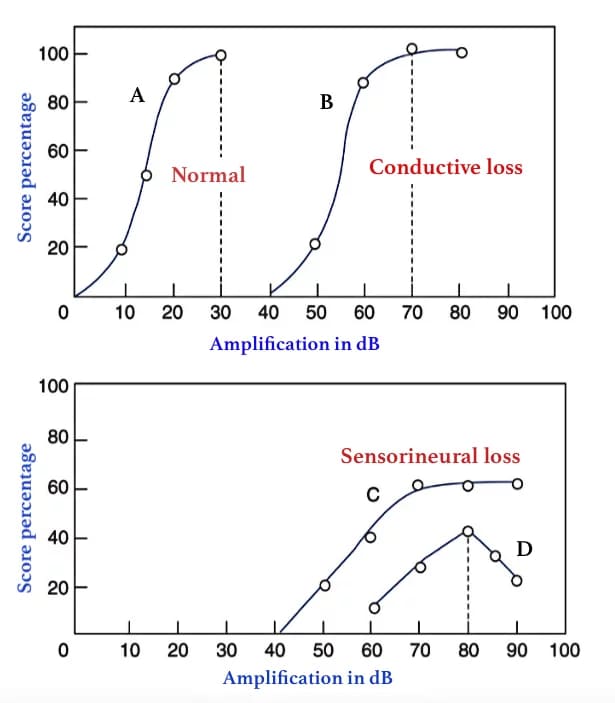
Benefits of speech audiometry :
- To measure the speech reception threshold which determines actual disability & not hearing impairment.
- To differentiate organic from nonorganic(functional) hearing loss.
- To find the intensity at which a hearing aid/cochlear implants fits and assessing rehabilitation outcome.
- To differentiate a cochlear from a retrocochlear sensorineural hearing loss.
3. Bekesy audiometry. It is an older, self-recording audiometric technique based on sweep and fixed frequency testing. In this method, various pure tone frequencies automatically shift from low to high, while the patient controls the intensity using a button. Two tracings are obtained: one with a continuous tone and the other with a pulsed tone. These tracings help differentiate between cochlear and retrocochlear hearing loss as well as between organic and functional hearing loss. However, Bekesy audiometry is seldom performed in contemporary practice.
The types of tracings obtained in Bekesy audiometry include:
- Type I: Continuous and pulsed tracings overlap, indicating normal hearing or conductive hearing loss.
- Type II: Continuous and pulsed tracings overlap up to 1000 Hz, after which the continuous tracing falls. This pattern is seen in cochlear loss.
- Type III: The continuous tracing falls below the pulsed tracing at 100–500 Hz, sometimes up to 40–50 dB. This pattern is indicative of a retrocochlear or neural lesion.
- Type IV: The continuous tracing falls below the pulsed tracing at frequencies up to 1000 Hz by more than 25 dB. This pattern is also seen in retrocochlear or neural lesions.
- Type V: The continuous tracing is above the pulsed tracing, which is characteristic of nonorganic hearing loss.
4. Impedance audiometry. It is an objective test used to assess middle ear function and mobility of the tympanic membrane. The word ‘impedance’ means resistance to the flow of acoustic energy, expressed in ohms. and compliance is expressed in cubic centimetre of air. It provides valuable otological and neurological information about the nature and site of a lesion. The middle ear functions as the ‘impedance matching device’. Any pathology in the middle ear may cause impedance mismatching and vary the amount of sound reflected back from the tympanic membrane leading to conductive deafness. Impedance audiometry measures the efficiency of the middle ear to perform this function.
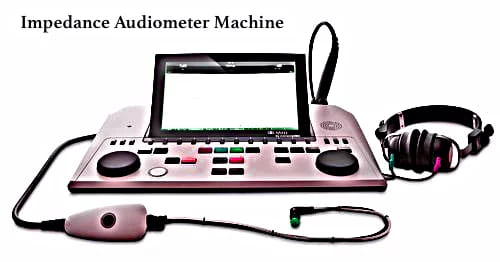
Impedance audiometer consists of a handheld probe which is hermetically sealed into the external auditory meatus forming a leak-free seal from the probe tip to the eardrum and has three channels: (i) first channel delivers a tone of 220 or 226 Hz, (ii) the second channel allows the reflected sound from the tympanic membrane to pass through a microphone amplifier assembly for processing (iii) the third channel is attached to air- pump-manometer system to bring about changes in air pressure in the ear canal from positive to normal and then negative(+300 to -600 mm of water pressure).
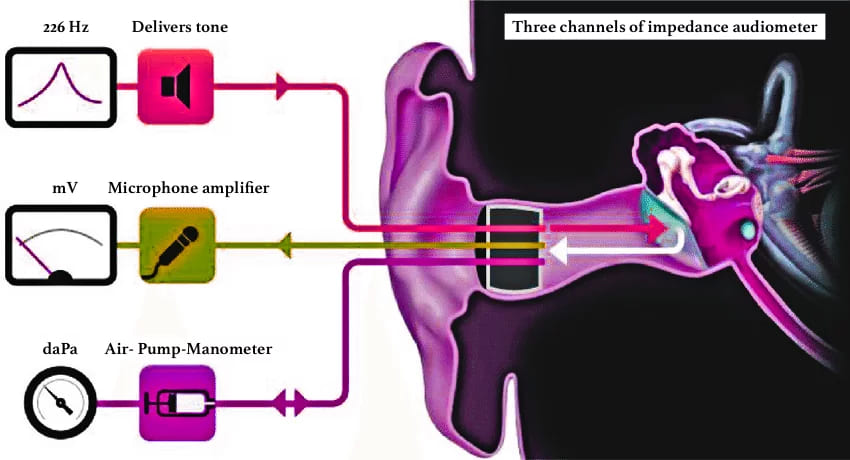
- Tympanometry
- Eustachian tube function test
- Acoustic/ stapedial reflex measurements
(i) Tympanometry. (one of the acoustic immittance tests) is the measurement of the change of impedance in the middle ear due to varying air pressure in the sealed external auditory meatus. A non-compliant/ stiff tympanic membrane tends to reflect back more sound energy as compared to a compliant TM. This reflected sound pressure is measured at the tip of the probe and charted in the graphical form of with impedance of the middle ear/compliance of TM on Y-axis and the air pressure on X-axis, called the tympanogram.
| Impedance is the opposition/ resistance to the flow of energy, admittance is the ease of movement with which the flow of energy occurs. For ease of measurement most clinical impedance audiometers measure the acoustic admittance. Admittance is reciprocal of impedance just like compliance is the reciprocal of stiffness. |
Procedure:
- Otoscopy is done to exclude scarring or perforation in the tympanic membrane
- Remove wax /discharge, if present and choose a well-fitted ear probe tip to create an air-tight seal.
- Mild sedation may be used in uncooperative patients and children.
- A probe is inserted into the ear. Increase the pressure to +200 mm of H2O. Reduce the pressure serially to 100, 50, 0 up to 400 mm of H2O to test the compliance at various pressures. Draw a graph with pressure on the X-axis and compliance on the Y-axis. The normal middle ear pressure is ± 25 mm of H2O, but for practical purposes, ± 100 mm of H2O is taken as normal.
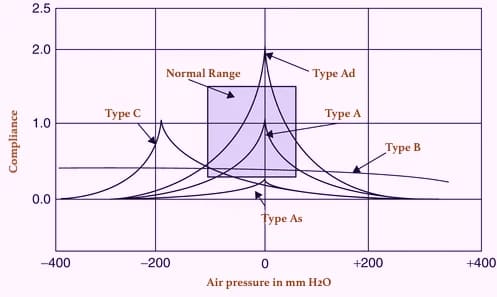
Types of tympanogram:
| Type A | Normal tympanogram (the peak is near zero pressure) |
| Type As | Compliance is lower at or near ambient air (zero) pressure. Hypo-mobile admittance is observed in otosclerosis, tympanosclerosis or malleus fixation. |
| Type Ad | High compliance at or near ambient pressure. Hypermobile admittance is observed in discontinuity of ossicular chain or thin, flaccid tympanic membrane. |
| Type B | A flat or dome-shaped graph. No change is seen in compliance with changes in pressure. This curve is seen in middle ear fluid, adhesive otitis media, thick or perforated TM, or grommet in situ. |
| Type C | Maximum compliance occurs with negative pressure in excess of 100 mm H2O. Seen in retracted tympanic membrane, fluid in middle ear. |
| Type D | A notched graph, seen in scarred and flaccid TM |
| Type E | An undulating graph, seen when an 8000 Hz sound is presented. This is seen in thick grafts after myringoplasty or in any mass. |
(ii) Eustachian tube function test. Tympanometry can be used to assess eustachian tube function and confirm the integrity of the auditory system. Eustachian tube dysfunction plays a dominant role in the pathogenesis of suppurative and non-suppurative otitis media. The prognosis and treatment of both types of otitis media are dependent upon the eustachian tube function. Tests which can be done are: (a) William’s test (b) Toynbee’s test (c) Acoustic immittance.
(a) William’s test. It is done in an intact tympanic membrane. The impedance audiometer is programmed to measure the middle ear pressure in three conditions (i) the middle ear pressure at the beginning of the test (resting pressure), (ii) after swallowing (with the nose pinched and mouth closed) and (iii) after performing Valsalva.
Inference:
- Normal ET function: Middle ear pressure is same as atmospheric pressure at rest, during swallowing or Valsalva.
- Impaired ET function: Pressure becomes negative during swallowing. It does not become positive on Valsalva or vice versa.
- Grossly impaired ET function. Pressure does not change at all in either of the situations.
(b) Toynbee’s test. is done in patients having a perforation in the tympanic membrane or grommet-in -situ. The test is similar to William’s test where negative or positive pressure (−250 or +250 mm H2O) is created in the middle ear and the person is asked to swallow five times in 20 seconds. The test is carried out for a fixed duration of time, e.g., 40 seconds (minimum) or 160 seconds (maximum). The ability to equilibrate the pressure with every act of swallowing indicates whether the patient is having normal tubal function or not.
(c) Acoustic immittance can also measure the physical volume of air between the probe tip and the tympanic membrane. Normally it is up to 1.0 mL in children and 2 mL in adults. Any increase in volume >2 mL in children and >2.5 mL in adults indicate perforation of the tympanic membrane (because middle ear volume is added up to the volume of the external ear canal). This has also been used to find patency of the ventilation tube.
(iii) Acoustic reflex. It is based on the fact that a loud sound 70–100 dB above hearing threshold of one ear, causes bilateral contraction of the stapedius muscle (which pulls the stapes slightly outward and upward) & and tensor tympani muscle (pulls the tympanic membrane slightly inward). The effect is more pronounced on the stapedius muscle than on tensor tympani. Stapedial reflex threshold (SRT): Minimal intensity of sound that produces stapedial reflex. (bilateral reflex)
Reflex arc:
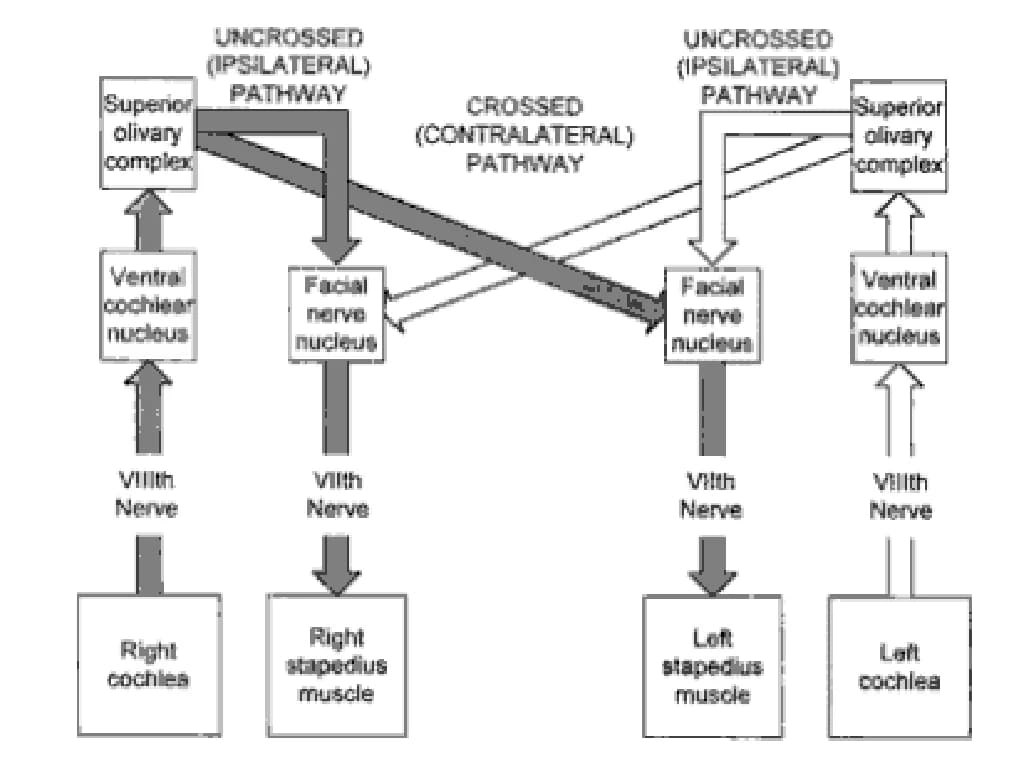
Ipsilateral ear: CN VIII → ventral cochlear nucleus → CN VII nucleus → ipsilateral stapedius muscle.
Contralateral ear: CN VIII → ventral cochlear nucleus → contralateral medial superior olivary nucleus → contralateral CN VII nucleus → contralateral stapedius muscle
Uses of acoustic reflex: It is very simple to perform, requires a few minutes, is a non-invasive objective test (does not depend upon subjective responses from the patient)
Acoustic reflex tests help the otolaryngologist/neurologist :
- To test the hearing in infants, young children and uncooperative patients.
- To assess middle ear function accurately.
- To differentiate cochlear and retro-cochlear pathology. In cochlear lesion, the stapedial reflex is present at lower intensities, e.g. 40–60 dB than the usual 70 dB(recruitment phenomenon)
- To detect brain-stem pathologies: If ipsilateral reflex is present but the contralateral reflex is absent, the lesion is in the area of crossed pathways in the brainstem.
- To detection non-organic hearing loss: A malingerer does not give any response on pure tone audiometry but shows a positive stapedial reflex.
- To identify the level of lesion in facial nerve paralysis: Absence of stapedial reflex when hearing is normal indicates a lesion of the facial nerve, proximal to the nerve to stapedius. The reflex can also be used to find prognosis of facial paralysis as the appearance of reflex after it was absent, indicates return of function and a favourable prognosis.
- To detect VIIIth nerve lesion: If a sustained tone of 500 or 1000 Hz, delivered 10 dB above acoustic reflex threshold, for a period of 10 s, brings the reflex amplitude to 50%, it shows abnormal adaptation and is indicative of VIIIth nerve lesion (stapedial reflex decay).
Special tests of Hearing.
- Recruitment
- SISI Test
- Threshold Tone Decay Test
- Auditory Evoked Potential
- Auditory Steady State Response (ASSR)
- Otoacoustic emmisions (OAE’s)
- Central Tests
1. Recruitment
Recruitment is a phenomenon where a sound of a particular intensity becomes abnormally loud and intolerable to a patient. Patients with recruitment experience an inability to hear low-intensity sounds in the affected ear, but high-intensity sounds are perceived as equally loud or even louder than in a normal hearing ear. Recruitment is commonly seen in patients with cochlear dysfunction, making them poor candidates for hearing aids.
The Alternate Binaural Loudness Balance (ABLB) test is used to detect recruitment in unilateral cases. In this test, a tone, such as 1000 Hz, is played alternately to the normal and affected ear, with the intensity in the affected ear adjusted to match the loudness in the normal ear. The test begins at 20 dB above the threshold of the deaf ear and is repeated at every 20 dB increase until the loudness is matched or the limits of the audiometer are reached. In cases of conductive and neural deafness, the initial difference is maintained throughout, while in cochlear lesions, partial, complete, or over-recruitment may be observed.
2. Short Increment Sensitivity Index (SISI)
The Short Increment Sensitivity Index (SISI) test assesses a patient’s ability to detect small changes in the intensity of pure tones. Patients with cochlear lesions can better appreciate these small changes compared to normal subjects or those with conductive or retro-cochlear dysfunction. Thus, the SISI test is used to differentiate cochlear from retro-cochlear lesions.
Procedure: A continuous, supra-threshold tone (20 dB above the hearing threshold) is presented to the patient for 2 minutes. The tone is then increased by 1 dB every 5 seconds, with 20 such increments. The patient is instructed to count the number of increments they hear.
Interpretation:
- Conductive deafness: SISI score < 15%
- Nerve deafness: SISI score 0–20%
- Cochlear deafness: SISI score 70–100%
Disadvantages: Patients with severe deafness (above 85 dB) cannot be tested with most clinical audiometers, and the test requires active cooperation from the patient.
3. Threshold Tone Decay Test
The Threshold Tone Decay Test measures auditory nerve fatigue or adaptation, specifically assessing how long a patient can continuously perceive a tone presented near their threshold.
Principle: Normally, a pure tone presented slightly above the absolute hearing threshold can be heard continuously for at least 60 seconds. However, in cases of retrocochlear lesions affecting the auditory nerve, the nerve’s ability to sustain firing decreases rapidly, causing the patient to stop hearing the tone much sooner.
Procedure:
- Present a tone at a frequency of 4000 Hz (or other frequencies) at an intensity 5 dB above the patient’s hearing threshold.
- Instruct the patient to indicate as long as they hear the tone, up to 60 seconds.
- If the patient stops hearing the tone before 60 seconds, increase the intensity by another 5 dB, and repeat the process.
- Continue this 5 dB incremental increase until the patient can hear the tone continuously for 60 seconds, or until the maximum output of the audiometer is reached.
- The total increase in intensity required to sustain the tone for 60 seconds (or the amount of decay observed) is measured in “decibels of decay.”
Interpretation:
- Normal Hearing/Conductive Loss/Cochlear Loss: Decay is typically less than 15-20 dB.
- Cochlear Hearing Loss: A decay between 15 and 20 dB may indicate cochlear hearing loss (often related to recruitment).
- Retrocochlear Lesion: A decay of more than 25 dB (significant tone decay) is highly diagnostic of a retrocochlear lesion (e.g., acoustic neuroma, auditory neuropathy), indicating auditory nerve fatigue or pathology.
4. Auditory Evoked Potentials (AEPs)
Auditory Evoked Potentials (AEPs) are objective tests that record the electrical potentials (brain waves) generated by various parts of the auditory pathway in response to auditory stimulation. An averaging computer is essential to extract these tiny potentials from the larger background electrical activity of the brain (EEG). While many AEP components exist, two have gained significant clinical acceptance: Electrocochleography (ECoG) and Brainstem Auditory Evoked Response (BAER/ABR).
(i) Electrocochleography (ECoG)
ECoG measures the electrical potentials generated specifically by the cochlea and the auditory nerve (CN VIII) in response to an auditory stimulus.
Potentials Measured: It records three main potentials:
- Cochlear Microphonics (CM): An alternating current (AC) potential generated primarily by the outer hair cells of the cochlea, which mirrors the waveform of the stimulus.
- Summating Potential (SP): A direct current (DC) potential reflecting the summed response of inner hair cells and possibly outer hair cells.
- Action Potential (AP): A compound action potential generated by the synchronized firing of many auditory nerve fibers (CN VIII).
Procedure: ECoG is an objective test providing a reasonably accurate measurement of hearing thresholds between 1000 Hz and 8000 Hz. It typically requires inserting a thin, needle-like active recording electrode through the tympanic membrane and placing it onto the promontory or round window (transtympanic ECoG). Reference and ground electrodes are placed on the mastoid process and forehead, respectively. This procedure is usually done under sedation or local anesthesia due to its invasive nature. (Non-invasive extratympanic ECoG also exists, with electrodes in the ear canal, but provides smaller responses).
Uses of ECoG:
- Diagnosing Meniere’s Disease: A significantly enlarged SP/AP ratio (typically > 0.4 in transtympanic ECoG) is a highly characteristic finding in Meniere’s disease, indicative of endolymphatic hydrops. This is a key diagnostic marker.
- Detecting Hearing Thresholds in Difficult-to-Test Populations: It can estimate hearing thresholds (within 5-10 dB) in young infants, children, and uncooperative patients.
- Differentiating Cochlear from Eighth Nerve Lesions: By analyzing the characteristics of CM, SP, and AP, ECoG helps pinpoint the site of lesion within the inner ear or auditory nerve.
- Intraoperative Monitoring: Surgeons use ECoG to monitor the function of the cochlea and cochlear nerve during neurotological surgical procedures (e.g., acoustic neuroma removal, vestibular neurectomy) to preserve hearing.
(ii) Brainstem Auditory Evoked Response (BAER or BERA / Auditory Brainstem Response – ABR)
ABR (Auditory Brainstem Response), also widely known as BAER or BERA, is an objective, non-invasive electrophysiological test that assesses the structural integrity and functional status of the auditory pathway from the spiral ganglia (distal CN VIII) to the level of the lateral lemniscus in the midbrain. Jewett and Williston introduced this test.
Principle: A series of very small electrical potentials are generated by the activation of different parts of the auditory system in response to brief auditory stimuli (clicks or tone bursts). These potentials are recorded by surface electrodes placed on the scalp. Since these neurogenic potentials are extremely small and “buried” in the background spontaneous electrical activity of the brain (EEG waves) and muscle activity (myogenic potentials), an averaging computer is required to summate the responses to hundreds or thousands of stimuli, effectively filtering out noise and revealing the consistent AEPs.
Procedure:
- Environment: Conduct the test in a quiet, sound-attenuating room.
- Patient State: The patient lies in a supine position, relaxed, with eyes closed, and preferably asleep (especially for children or uncooperative adults) to reduce myogenic potentials. Accurate assessment in children often requires mild sedation.
- Testing Protocol: Test one ear at a time.
- Electrode Placement: Three surface electrodes are typically used:
- Active Electrode: Placed on the vertex of the scalp (the best location) or, if not feasible, on the top of the forehead just below the hairline.
- Reference Electrode: Placed on the earlobe or mastoid of the tested ear.
- Ground Electrode: Placed on the earlobe or mastoid of the opposite ear.
- Stimulus: A series of 1000-2000 clicks (broadband stimuli, effective for higher frequencies) are delivered at a rapid rate (e.g., 11.1 clicks/second) at an intensity of typically 60-80 dB nHL (normalized hearing level, which correlates to average normal hearing). Tone bursts can be used for more frequency-specific information.
- Recording Window: The neurogenic potentials elicited are recorded for the first 10-15 milliseconds after stimulus onset. This specific time window captures the electrical responses as they travel through the brainstem alone.
- Waveforms: In a normal-hearing person, ABR typically produces seven distinct waves (I-VII) in the first 10-15 milliseconds. Waves I, III, and V are the most stable and clinically significant for interpretation.
Characteristics of ABR Waves: The interpretation of ABR relies on analyzing three main characteristics:
- Latency:
- Absolute Latency: The time interval (in milliseconds) between the onset of the stimulus and the peak of a specific wave.
- Inter-wave Latency (Interpeak Latency): The time interval between two different waves in the same ear and the same ABR tracing (e.g., I-III interval, III-V interval, I-V interval). This reflects conduction time between specific brainstem nuclei.
- Interaural Latency Difference: The difference in the absolute latency of the same wave (most commonly Wave V) between the two ears. A significant interaural difference (e.g., > 0.2-0.3 ms for Wave V) can indicate unilateral pathology.
- Amplitude: The peak-to-trough voltage of each wave. (Less stable and less clinically used than latency).
- Morphology: The shape and clarity of the waves.
Upper Limits of Normal ABR Values (Approximate):
- Latency of Wave V: ~5.5 – 5.9 ms
- I–V Inter-wave Interval: ~4.0 – 4.4 ms
- I–V Interaural Latency Difference: < 0.3 ms
Anatomical Generators of ABR Waves (EE COLI Mnemonic for NEET PG):
- Wave I: Distal portion of the VIIIth Cranial Nerve (Auditory Nerve), near the cochlea.
- Wave II: Proximal portion of the VIIIth Cranial Nerve, near the brainstem.
- Wave III: Cochlear Nucleus (in the pons).
- Wave IV: Superior Olivary Complex (in the pons).
- Wave V: Lateral Lemniscus (at the level of the inferior colliculus in the midbrain). This is the most robust and clinically important wave, often used for threshold estimation.
- Waves VI and VII: Inferior Colliculus and higher brainstem pathways.
- Mnemonic (EE COLI): Eighth nerve (distal), Eighth nerve (proximal), Cochlear nucleus, Olivary complex, Lateral Iemniscus, Inferior colliculus. (Compare with E COLI-MA in pathways of hearing, indicating how the mnemonic maps to the pathway).
| Wave I | Distal part of CN VIII |
| Wave II | Proximal part of CN VIII near the brainstem |
| Wave III | Cochlear nucleus |
| Wave IV | Superior olivary complex |
| Wave V | Lateral lemniscus |
| Waves VI and VII | Inferior colliculus |
As per latest studies these are anatomic site of neural generators for various waves.
Uses of ABR: ABR is a versatile test with numerous applications:
- Objective Hearing Assessment: It is the gold standard objective test for estimating hearing thresholds in infants, young children, non-cooperative adults, malingerers, and comatose/unconscious patients. It requires minimal patient cooperation.
- Diagnosing Retrocochlear Pathologies: ABR is highly sensitive (around 90-95%) for detecting lesions of the auditory nerve or brainstem, particularly acoustic neuromas (vestibular schwannomas). Prolongation of absolute latencies (especially Wave V), prolongation of inter-wave latencies (e.g., I-V interval), or a significant interaural latency difference strongly suggests a retrocochlear lesion.
- Diagnosing Brainstem Pathology: It can help identify the site of lesions within the brainstem, such as those caused by multiple sclerosis or pontine tumors, which affect neural conduction.
- Intraoperative Monitoring: Surgeons use ABR to monitor and preserve the auditory nerve (CN VIII) during complex neurotological surgeries, such as the removal of acoustic neuromas or other cerebellopontine angle tumors. This helps prevent iatrogenic hearing loss.
Disadvantages and Limitations of ABR:
- Not Frequency-Specific: ABR, especially when using clicks, primarily reflects high-frequency hearing (2000-4000 Hz) due to the transient nature of the click stimulus. It does not give precise frequency-specific information across the entire audiometric range, and low-frequency hearing losses are often undetectable. Therefore, additional tests like ASSR are needed for a comprehensive frequency-specific audiogram in objective assessments.
- Sensitivity for Small Tumors: While highly sensitive for detecting large tumors, ABR may miss small acoustic neuromas (<1 cm). Therefore, MRI remains a more sensitive and specific test for definitive diagnosis of acoustic neuroma.
- Effect of Hearing Loss: ABR waves are typically absent or severely distorted in patients with severe or profound hearing loss (>75 dB HL). Conductive hearing loss also attenuates cochlear stimulation and prolongs ABR wave latencies, necessitating careful interpretation and often masking.
- No “Gold Standard” Standardization: While widely used, there isn’t a single universal standardization for ABR interpretation across all clinics.
- Age and Consciousness: While valuable for non-cooperative patients, ABR testing itself requires the patient to be relatively still and quiet. Although sedation does not affect the ABR waves, it may be needed for accurate assessment in infants and young children, adding complexity.
- Wave I Identification: Wave I is often not easily identifiable, particularly at lower stimulus intensities, which can make I-III and I-V interval calculations challenging.
5. Auditory Steady State Response
It is an electrophysiological test to predict the frequency-specific hearing thresholds. The steady-state pure tone signals(modulated in amplitude and frequency) are used in ASSR unlike, the transient signals of tone bursts or clicks used in ABR producing a frequency-specific audiogram.
Uses :
- Hearing loss of more than 80 dB can be detected. It can help in the early detection of the children who need cochlear implantation.
- ASSR can be done in all ages, any mental state, and any degree of hearing loss.
- Multiple frequencies can be assessed at the same time, as long as their carrier frequencies utilize different modulation rates.
- ASSR is an objective test that can be analysed and interpreted easily using statistical methods.
6. Otoacoustic emissions (OAEs). An ever-evolving, fast, easy-to-obtain, minimally invasive screening test used for screening for hearing loss in early life. OAE tests play an important role in monitoring ototoxicity and noise-induced hearing loss (NIHL) because OAEs can detect outer hair cell dysfunction earlier than a pure tone audiogram can.
Pathophysiology: OAEs are the sounds of low intensity produced by the outer hair cells of a normal cochlea and recorded from the external auditory canal with the help of a sensitive microphone placed in the external ear canal. The sound produced by the outer hair cells travels in a reverse direction: outer hair cells → basilar membrane → perilymph → oval window → ossicles → tympanic membrane → ear canal.
OAEs are present in healthy outer hair cells, thus helps to test the functional status of the cochlea. OAE’s are absent in 50% of normal individuals, lesions of the cochlea, middle ear disorders (as sound travelling in the reverse direction cannot be picked up) and when the hearing loss exceeds 30 dB.
Types of OAEs:
(i) Spontaneous OAE’s are seen in the persons with normal hearing or when hearing loss < 30 dB.
(ii) Evoked OAE’s. Depending on the sound stimulus used, evoked OAE may be:
- Transient evoked OAEs (TEOAEs): A series of click stimuli are presented at 80–85 dB SPL (sound pressure level) and the response is recorded. TEOAEs can be recorded from 500–4000Hz but are more sensitive for hearing loss at 500 and 1000 Hz.
- Distortion product OAEs (DPOAEs): Two continuous tones of moderate-intensity, e.g. 55 and 65dB SPL, are presented to the cochlea at the same time to produce distortion. They are used to test hearing in the range of 1000–8000 Hz but have a better clinical performance for hearing loss at 4000 Hz.
Uses of OAE’s
- OAEs is used to distinguish between deafness caused by cochlear and retro-cochlear lesions. OAEs are absent in cochlear lesions, e.g. ototoxic sensorineural hearing loss.
- DPOAEs may be used to monitor ototoxicity effects earlier than pure tone audiometry.
- It may also be used in non-cooperative or mentally unwell patients, in non-organic hearing loss after giving sedation. Sedation does not affect OAEs.
Disadvantages:
- It is advisable to do tympanometry with OAEs because the middle ear pathology may interfere with the recording of OAEs. There are chances that the clinicians may misinterpret the absence of OAEs as a sensorineural hearing loss if they are unaware of the existence of middle ear pathology.
- OAEs may not diagnose the auditory neuropathy in the neonates. Auditory neuropathy is a hearing disorder characterized by abnormal or absent auditory brainstem response in the presence of normal outer hair cell function. Therefore, AABR is the best method in the NICU/SCBU population to detect auditory neuropathy.
OAE test results are affected by the ambient noise level and the patient’s internal noise level (e.g. breathing or body movements. Therefore, the results of OAE tests should be interpreted in conjunction with pure tone audiometry, tympanometry etc.
7. Central Auditory Tests, Auditory processing disorder, Central deafness. The patients with the central auditory pathology have difficulty in hearing a distorted, unclear speech and also when there is some background noise like in a party. They have normal pure-tone hearing thresholds and other hearing tests but cannot follow instructions. These problems are due to poor processing of the auditory cues in the higher auditory pathways.
Types of speech discrimination tests :
- A message is presented in a distorted speech. Patients with cortical lesions will face difficulty in understanding the message.
- Two different speech messages (a pair of spondaic words along with digits or nonsense words) are presented at the same time, one to each ear and the patient is asked to identify both. The patients with temporal lobe lesions will have difficulty identifying these words when presented to the ear opposite to that of the side of the lesion.
- Binaural tests. They are used to identify the integration of information from both ears. Such tests are normal in cortical lesions but affected in lesions of brainstem and thus help to localize the site of the lesion. A most common test used is the binaural masking level difference test.
———— End of the chapter ————
Download full PDF Link:
Reference Textbooks.
- Scott-Brown, Textbook of Otorhinolaryngology-Head and Neck Surgery.
- Glasscock-Shambaugh, Textbook of Surgery of the Ear.
- P L Dhingra, Textbook of Diseases of Ear, Nose and Throat.
- Hazarika P, Textbook of Ear Nose Throat And Head Neck Surgery Clinical Practical.
- Mohan Bansal, Textbook of Diseases of Ear, Nose and Throat Head and Neck Surgery
- Hans Behrbohm, Textbook of Ear, Nose, and Throat Diseases With Head and Neck Surgery.
- Salah Mansour, Middle Ear Diseases – Advances in Diagnosis and Management.
- Logan Turner, Textbook of Diseases of The Nose, Throat and Ear Head And Neck Surgery.
- Rob and smith, Textbook of Operative surgery.
- Anirban Biswas, Textbook of Clinical Audio-vestibulometry.
- Arnold, U. Ganzer, Textbook of Otorhinolaryngology, Head and Neck Surgery.
Author:

Dr. Rahul Bagla
MBBS (MAMC, Delhi) MS ENT (UCMS, Delhi)
Fellow Rhinoplasty & Facial Plastic Surgery.
Renowned Teaching Faculty
Mail: msrahulbagla@gmail.com
India
———– Follow us on social media ————
- Follow our Facebook page: https://www.facebook.com/Dr.Rahul.Bagla.UCMS
- Follow our Instagram page: https://www.instagram.com/dr.rahulbagla/
- Subscribe to our Youtube channel: https://www.youtube.com/@Drrahulbagla
- Please read. Anatomy of External Ear. https://www.entlecture.com/anatomy-of-ear/
- Please read. Anatomy of Temporal Bone. https://www.entlecture.com/anatomy-of-temporal-bone/
- Please read. Stenger’s, Chimani Moos, Teal test. https://www.entlecture.com/special-tuning-fork-tests/
